Roman funerary practices
| Religion in ancient Rome |
|---|
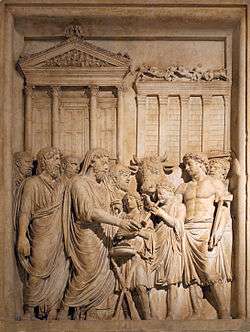 |
| Practices and beliefs |
| Priesthoods |
| Deities |
|
| Related topics |
Roman funerary practices include the Ancient Romans' religious rituals concerning funerals, cremations, and burials. They were part of the Tradition (Latin: mos maiorum).[1]
Roman cemeteries were located outside the sacred boundary of its cities (pomerium). They were visited regularly with offerings of food and wine, and special observances during Roman festivals in honor of the dead. Funeral monuments appear throughout the Roman Empire, and their inscriptions are an important source of information for otherwise unknown individuals and history. A Roman sarcophagus could be an elaborately crafted art work, decorated with relief sculpture depicting a scene that was allegorical, mythological, or historical, or a scene from everyday life.
Although funerals were primarily a concern of the family, which was of paramount importance in Roman society, those who lacked the support of an extended family usually belonged to guilds or collegia which provided funeral services for members.
Care of the dead
In Greco-Roman antiquity, the bodies of the dead were regarded as polluting.[2] At the same time, loving duty toward one's ancestors (pietas) was a fundamental part of ancient Roman culture.[3] The care of the dead negotiated these two emotionally opposed attitudes.
Preparation of the body
When a person died at home, family members and intimate friends gathered around the death bed. In accordance with a belief that equated the soul with the breath, the closest relative sealed the passing of spirit from the body with a last kiss, and closed the eyes. The relatives began lamentations, calling on the deceased by name. The body was then placed on the ground, washed, and anointed. The placing of the body on the ground is a doublet of birth ritual, when the infant was placed on the bare earth.[4] Male citizens were then dressed in a toga, and others in attire appropriate to their station in life. Men who had earned a wreath wore one in death,[5] and wreaths also are found in burials of initiates into mystery religions.[6] After the body was prepared, it lay in state in the atrium of the family home (domus), with the feet pointed toward the door.[7] Other circumstances pertained to those who lived, as most Romans did, in apartment buildings (insulae), but elite practices are better documented.
Although embalming was unusual and regarded as mainly an Egyptian practice, it is mentioned in Latin literature, with a few instances documented by archaeology in Rome and throughout the Empire where no Egyptian influence can be assumed.[8] Since elite funerals required complex arrangements, the body had to be preserved in the mean time.[9]
Other customs
"Charon's obol" was a coin placed in or on the mouth[10] of the deceased. The custom is recorded in literary sources and attested by archaeology, and sometimes occurs in contexts that suggest it may have been imported to Rome as were the mystery religions that promised initiates salvation or special passage in the afterlife. The custom was explained by the myth of Charon, the ferryman who conveyed the souls of the newly dead across the water — a lake, river, or swamp — that separated the world of the living from the underworld. The coin was rationalized as his payment; the satirist Lucian remarks that in order to avoid death, one should simply not pay the fee. In Apuleius's tale of "Cupid and Psyche" in his Metamorphoses, framed by Lucius's quest for salvation ending with initiation into the mysteries of Isis, Psyche ("Soul") carries two coins in her journey to the underworld, the second to enable her return or symbolic rebirth. Evidence of "Charon's obol" appears throughout the Western Roman Empire well into the Christian era, but at no time and place was it practiced consistently and by all.
Disposal of the body
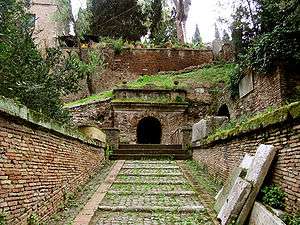
Although inhumation was practiced regularly in archaic Rome, cremation was the most common burial practice in the Mid- to Late Republic and the Empire into the 1st and 2nd centuries. Crematory images appear in Latin poetry on the theme of the dead and mourning. In one of the best-known classical Latin poems of mourning, Catullus writes of his long journey to attend to the funeral rites of his brother, who died abroad, and expresses his grief at addressing only silent ash.[11] When Propertius describes his dead lover Cynthia visiting him in a dream, the revenant's dress is scorched down the side and the fire of the pyre has corroded the familiar ring she wears.[12]
Ultimately, inhumation would replace cremation; a variety of factors, including decreasing levels of urbanization and changes in attitudes to the afterlife, would contribute to this marked shift in popular burial practices. The care and cultivation of the dead did not end with the funeral and formal period of mourning, but was a perpetual obligation. Libations were brought to the grave, and some tombs were even equipped with "feeding tubes" to facilitate delivery. (See below.)
Funeral rites
Funeral rites took place at home and at the place of burial,[13] which was located outside the city to avoid the pollution of the living.[14] The funeral procession (pompa funebris) transited the distance between the two.
A professional guild (collegium) of musicians specialized in funeral music.[15] Horace mentions the tuba and the cornu, two bronze trumpet-like instruments, at funerals.[16]
Eulogy
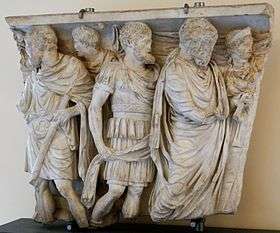
The eulogy (laudatio funebris) was a formal oration or panegyric in praise of the dead. It was one of two forms of discourse at a Roman funeral, the other being the chant (nenia).[17] The practice is associated with noble families, and the conventions for words spoken at an ordinary person's funeral go unrecorded. While oratory was practiced in Rome only by men, an elite woman might also be honored with a eulogy.
For socially prominent individuals, the funeral procession stopped at the forum for the public delivery of the eulogy from the Rostra.[18] Thus a well-delivered funeral oration could be a way for a young politician to publicize himself.[19] Aunt Julia's Eulogy (Laudatio Juliae Amitae), a speech made by the young Julius Caesar in honor of his aunt, the widow of Gaius Marius, helped launch his political career as a populist.[20]
The epitaph of the deceased in effect was a digest of the eulogy made visible and permanent,[21] and might include the career (Template:Cursus honorum) of a man who had held public offices. In commemorating past deeds, the eulogy was a precursor to Roman historiography.
Sacrifices
After the body was carried to the cemetery, a sacrifice was performed in the presence of the corpse. Until the time of Cicero, it was customary to offer a sow to Ceres, a sow also being a characteristic offering to chthonic deities. The sacrificial victim was then allotted for consumption among the participants. The portion for the deceased was put on a spit and cremated with the body. Ceres' portion was burned on an altar. The family ate the portion that was due the living. A family of lesser means offered a libation of wine, incense, produce or grain; the allocation of these offerings is not recorded.[22] After this apportioning, the deceased had transitioned and could no longer share in the meals of the living and the domestic gods; he now partook of what was appropriate for the spirits of the dead, the Manes.[23]
Commemorations
Novendialis
On the ninth day after the person died, the funeral feast and rites called the novendialis or novemdialis were held.[24] A libation to the Manes was poured onto the grave. This concluded the period of full mourning.[25]
Festivals of the dead
In February, the last month of the original Roman calendar when March 1 was New Year's Day, the dead were honored at a nine-day festival called the Parentalia, followed by the Feralia on February 21, when the potentially malign spirits of the dead were propitiated. During the Parentalia, families gathered at cemeteries to offer meals to the ancestors, and then shared wine and cakes among themselves (compare veneration of the dead in other cultures). Tombs for wealthy, prominent families were constructed as "houses", with a decorated room for these banqueting festivities.[26]
Epitaphs
Epitaphs are one of the major classes of inscriptions. An epitaph usually noted the person's day of birth and lifespan.[27] Information varies, but collectively they offer information on family relationships, political offices,[28] and Roman values, in choosing what aspects of the deceased's life to praise.
Philosophical beliefs may also be in evidence. The epitaphs of Epicureans often expressed some form of the sentiment non fui, fui, non sum, non desidero, "I did not exist, I have existed, I do not exist, I feel no desire,"[29] or non fui, non sum, non curo, "I did not exist, I do not exist, I'm not concerned about it."[30]
Funerary art
"Images"


Noble Roman families often displayed a series of "images" (sing. imago, pl. imagines) in the atrium of their family home. [31] There is some uncertainty about whether these "images" were funeral masks, busts, or both together. The "images" could be arranged in a family tree, with a title (titulus) summarizing the individual's offices held (honores) and accomplishments (res gestae),[35] a practice that might be facilitated by hanging masks.[36] In any case, portrait busts of family members in stone or bronze were displayed in the home as well.[37]
Funeral masks were most likely made of wax and possibly molded as death masks directly from the deceased. They were worn in the funeral procession either by actors who were professional mourners, or by appropriate members of the family. Practice may have varied by period or by family, since sources give no consistent account.[38]
The display of ancestral images in aristocratic houses of the Republic and the public funerals are described by Pliny, Natural History 35, 4-11.[39]
Since references to "images" often fail to distinguish between commemorative portrait busts, extant examples of which are abundant, or funeral masks made of more perishable materials, none can be identified with certainty as having survived. The veristic tradition of funerary likenesses, however, contributed to the development of realistic Roman portraiture. In Roman Egypt, the Fayum mummy portraits reflect traditions of Egyptian and Roman funerary portraiture and the techniques of Hellenistic painting.
Sarcophagi
The funerary urns in which the ashes of the cremated were placed were gradually overtaken in popularity by the sarcophagus as inhumation became more common. Particularly in the 2nd–4th centuries, these were often decorated with reliefs that became an important vehicle for Late Roman sculpture. The scenes depicted were drawn from mythology, religious beliefs pertaining to the mysteries, allegories, history, or scenes of hunting or feasting. Many sarcophagi depict Nereids, fantastical sea creatures, and other marine imagery that may allude to the location of the Isles of the Blessed across the sea, with a portrait of the deceased on a seashell.[40] The sarcophagus of a child may show tender representations of family life, Cupids, or children playing.
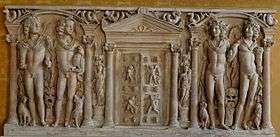
Some sarcophagi may have been ordered during the person's life and custom-made to express their beliefs or aesthetics. Most were mass-produced, and if they contained a portrait of the deceased, as many did, with the face of the figure left unfinished until purchase.[42] The carved sarcophagus survived the transition to Christianity, and became the first common location for Christian sculpture, in works like the mid 4th-century Sarcophagus of Junius Bassus.[43]
Tombs
Wealthy vs. Commoners
Ancient Rome has become an excavation site known for its rather extravagant cemeteries. All in all, the commoners and wealthy families of Rome were buried in the same cemeteries; the wealthy, however, had more elaborate tombs. The tombs of the wealthy were typically cut out of bedrock and rectangular in shape.[44] These rectangular tombs resembled the Ancient Roman's house structure, having doors, and many different chambers.[45] Of these chambers, one of them was used to hold the dead's memorial ceremony. During this ceremony, the family of the deceased would get together and have dinner. Other chambers were used to house anything thought necessary for the person laid to rest – including portraits of the deceased and any paraphernalia needed for the memorial ceremony that had yet to come.[46]
Wealthy and prominent families had large, sometimes enormous, mausoleums. The Castel Sant'Angelo by the Vatican, originally the mausoleum of Hadrian, is the best preserved, as it was converted to a fortress.[47] The Tomb of the Scipios was the family tomb of the Scipios, located in an aristocratic cemetery, and in use from the 3rd century BC to the 1st century AD. A grand mausoleum might include bedrooms and kitchens for family visits which would include feasts. For the wealthy middle class, smaller mausolea lined the roads from cities, many of which still remain in the Tombs of Via Latina, along the Appian Way, and elsewhere. The Tomb of Eurysaces the Baker is a famous and originally very ostentatious tomb in a prime spot just outside the Porta Maggiore, erected for a rich freedman baker around 50-20 BC.[48] The tombs at Petra, in the far east of the Empire are cut into cliffs, some with elaborate facades in the "baroque" style of the Imperial period. The less wealthy made do with smaller tombs, often featuring relief busts over a lengthy inscription. Cheaper still were the Catacombs of Rome, famously used by Christians, but also by all religions, with some specialization, such as special Jewish sections. These were large systems of narrow tunnels in the soft rock below Rome, where niches were sold to the families of the deceased in a very profitable, if rather smelly, trade. Decoration included paintings, many of which have survived.[49] The exterior of the tomb resembled that of a garden. Beautiful flowers and plants decked the outside of the tombs and made them more flattering to the eye. This was probably were the tradition of bringing flowers to a loved one’s grave site began. Other items were also added to the outside of the wealthy’s tombs to make it more decorative. The burial chamber of the deceased was above ground and stocked with relics that were important to the deceased Roman.[50] Lack of relics found in excavated tombs was most probably due to grave robbing.
In the Christian period, it became desirable to be buried near the grave of a famous martyr, and large funeral halls were opened over such graves, which were often in a catacomb underneath. These contained rows of tombs, but also space for meals for the family, now probably to be seen as agape feasts. Many of the large Roman churches began as funeral halls, which were originally private enterprises; the family of Constantine owned the one over the grave of Saint Agnes of Rome, whose ruins are next to Santa Costanza, originally a Constantinian family mausoleum forming an apse to the hall.[51][52]
Military funerals and burial
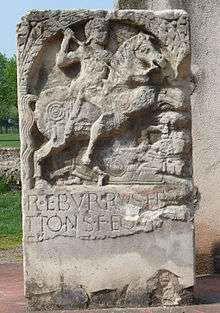
"The cult of the dead," it has been noted,[53] "was particularly important to men whose profession exposed them to a premature demise." The Roman value of pietas encompassed the desire of soldiers to honor their fallen comrades, though the conditions of war might interfere with the timely performance of traditional rites.[54] Soldiers killed in battle on foreign soil with ongoing hostilities were probably given a mass cremation or burial.[55] Under less urgent circumstances, they might be cremated individually, and their ashes placed in a vessel for transport to a permanent burial site.[56] When the Roman army under the command of Publius Quinctilius Varus suffered their disastrous defeat at the Battle of Teutoburg Forest in 9 AD, they remained uncommemorated until Germanicus and his troops located the battlefield a few years later and made a funeral mound for their remains.[57]
In the permanent garrisons of the Empire, a portion of each soldier's pay was set aside and pooled for funeral expenses, including the ritual meal, the burial, and commemoration.[58] Soldiers who died of illness or an accident during the normal routines of life would have been given the same rites as in civilian life.[59] The first burial clubs for soldiers were formed under Augustus; burial societies had existed for civilians long before. Veterans might pay into a fund upon leaving the service, insuring a decent burial by membership in an association for that purpose.[60]
Tombstones and monuments throughout the Empire document military personnel and units stationed at particular camps (castra). If the body could not be recovered, the death could be commemorated with a cenotaph.[61] Epitaphs on Roman military tombstones usually give the soldier's name, his birthplace, rank and unit, age and years of service, and sometimes other information such as the names of his heirs. Some more elaborate monuments depict the deceased, either in his parade regalia[62] or in civilian dress to emphasize his citizenship.[63] Cavalrymen are often shown riding over the body of a downtrodden foe, an image interpreted as a symbolic victory over death.[64] Military funeral monuments from Roman Africa take progressively more substantial forms: steles in the 1st century, altars in the 2nd, and cupulas (mounds) in the 3rd. Tombs were often grouped in military cemeteries along the roads that led out of the camp. A centurion might be well-off enough to have a mausoleum built.[65]
If a commander was killed in action, the men rode or marched around his pyre, or in some circumstances a cenotaph.[66]
Afterlife
Religion
Standard accounts of Roman mythology describe the soul as immortal[67] and judged at death before a tribunal in the underworld,[68] with those who had done good being sent to the Elysian Fields and those who had done ill sent to Tartarus.[69] It is unclear how ancient such beliefs were, as they seem influenced by Greek mythology and mystery cults.
The mysteries continued under Rome and seem to have promised immortality only for the initiated. Known forms of esoteric religion combined Roman, Egyptian, and Middle Eastern mythology and astrology, describing the progress of its initiates through the regions of the moon, sun, and stars. The uninitiated or virtueless were then left behind, the underworld becoming solely a place of torment. Common depictions of the afterlife of the bless include rest, a celestial banquet, and the vision of God (Deus or Jupiter).[70]
Philosophy
The mainstream of Roman philosophy, such as the Stoics, advocated contemplation and acceptance of the inevitability of death of all mortals. "It is necessary for some to stay and for others to go, all the while rejoicing with those who are with us, yet not grieving for those departing."[71] To grieve bitterly is to fail to perceive and accept the nature of things. Famously, Epictetus encouraged contemplation of one's loved ones as a "jar" or "crystal cup" which might break and be remembered without troubling the spirit, since "you love a mortal, something not your own. It has been given to you for the present, not inseparably nor forever, but like a fig... at a fixed season of the year. If you yearn for it in the winter, you are a fool."[72] There was no real consensus, at least among surviving Roman texts and epitaphs, of what happened to a person after death or the existence of an afterlife. Pliny the Elder in his Naturalis Historia claims that most people are of the opinion that after death one returns to the non-sensing state that occurred before birth but admits, however scornfully, that there are people who believe in the immortality of the soul.[73] Seneca the Younger seems to be less consistent, arguing both sides, indicating that death brings about utter annihilation while also talking about some survival of the spirit after it escapes from the prison of the body.[74] Tacitus at the end of Agricola takes the opposite opinion to Pliny, and claims that the wise believe the spirit does not die with the body, although he may be specifically referring to the pious [75] – which harkens to the mythological idea of Elysium. It is important to keep in mind that these are the opinions of a select few well-educated elite males and may not be characteristic of all of Roman views.
See also
- Rosalia, a festival of rose-adornment reflecting the practice decorating tombs and cemeteries with flowers
- Ancient Greek funeral and burial practices
- Roman funerary art
- Sit tibi terra levis
References
- ↑ Literally, the "way of the greater ones" but understood as "the way of the ancestors".
- ↑ Michele Renee Salzman, "Religious koine and Religious Dissent," in A Companion to Roman Religion (Blackwell, 2007), p. 116.
- ↑ Stefan Heid, "The Romanness of Roman Christianity," in A Companion to Roman Religion, p. 408.
- ↑ Anthony Corbeill, Nature Embodied: Gesture in Ancient Rome (Princeton University Press, 2004), p. 90, with a table of other parallels between birth and death rituals on p. 91.
- ↑ J.M.C. Toynbee, Death and Burial in the Roman World (Johns Hopkins University Press, 1971, 1996), pp. 43–44.
- ↑ Minucius Felix, Octavius 28.3–4; Mark J. Johnson, “Pagan-Christian Burial Practices of the Fourth Century: Shared Tombs?” Journal of Early Christian Studies 5 (1997), p. 45.
- ↑ Toynbee, Death and Burial, p. 44.
- ↑ Toynbee, Death and Burial, pp. 39, 41–42.
- ↑ Heller, L. John, Burial Customs of the Romans, (Washington: Classical Association of the Atlantic States, 1932), 194.
- ↑ No ancient Greek or Latin source says that coins were placed on the eyes; the archaeological evidence points overwhelming to placement in or on the mouth, in or near the hand, or loosely in the grave. Coins that could be interpreted as placement on the eyes is relatively rare.
- ↑ Catullus, Carmen 101, line 4 (mutam … cinerem).
- ↑ Propertius 4.7.8–9.
- ↑ Frances Hickson Hahn, "Performing the Sacred: Prayers and Hymns," in A Companion to Roman Religion, p. 238.
- ↑ Salzman, "Religious koine and Religious Dissent," p. 116.
- ↑ Friederike Fless and Katja Moede, "Music and Dance: Forms of Representation in Pictorial and Written Sources," in A Companion to Roman Religion, p. 252.
- ↑ Horace Satire 1.6.45.
- ↑ Ann Suter, Lament: Studies in the Ancient Mediterranean and Beyond (Oxford University Press, 2008), p. 258.
- ↑ Geoffrey S. Sumi, "Power and Ritual: The Crowd at Clodius' Funeral," Historia 46.1 (1997), p. 96.
- ↑ Brendon Reay, "Agriculture, Writing, and Cato's Aristocratic Self-Fashioning," Classical Antiquity 24.2 (2005), p. 354.
- ↑ Gerard B. Lavery, "Cicero's Philarchia and Marius," Greece & Rome 18.2 (1971), p. 139.
- ↑ R.G. Lewis, Aufstieg und Niedergang der römischen Welt (1993), p. 658.
- ↑ John Scheid, "Sacrifices to Gods and Ancestors," in A Companion to Roman Religion, pp. 264, 270.
- ↑ Scheid, "Sacrifices to Gods and Ancestors," p. 271.
- ↑ Salzman, "Religious koine and Religious Dissent," p. 115.
- ↑ Toynbee, Death and Burial in the Roman World, p. 51.
- ↑ Regina Gee, "From Corpse to Ancestor: The Role of Tombside Dining in the Transformation of the Body in Ancient Rome," in The Materiality of Death: Bodies, Burials, Beliefs, Bar International Series 1768 (Oxford, 2008), p. 59ff.
- ↑ Salzman, "Religious koine and Religious Dissent," p. 116.
- ↑ Jack N. Lightstone, "Roman Diaspora Judaism," in A Companion to Roman Religion, p. 350.
- ↑ CIL 8.3463; Attilio Mastrocinque, "Creating One's Own Religion: Intellectual Choice," in A Companion to Roman Religion, p. 379.
- ↑ These became such standard sentiments that abbreviations came into inscriptional usage, for this last example NF NS NC.
- ↑ A supposed ius imaginis ("right of the image") has sometimes been thought to restrict this privilege to the nobiles based on a single passage by Cicero, but scholars now are more likely to see the display of ancestral images as a social convention or product of affluence. See, for instance, Walker and Burnett.[32] and others.[33][34]
- ↑ Walker, Susan & al. The Image of Augustus, p. 9. British Museum Publications, 1981. ISBN 0714112704.
- ↑ 1
- ↑ 2
- ↑ R.G. Lewis, "Imperial Autobiography, Augustus to Hadrian," Aufstieg und Niedergang der römischen Welt II.34.1 (1993), p. 658.
- ↑ Rabun Taylor, "Roman Oscilla: An Assessment," RES: Anthropology and Aesthetics 48 (2005) 83–105.
- ↑ Lewis, "Imperial Autobiography," p. 658.
- ↑ Walker & Burnett, pp. 9-10
- ↑ Winkes, Rolf: Imago Clipeata, Studien zu einer römischen Bildnisform, Bonn 1969. Winkes, Rolf: Pliny's chapter on Roman funeral customs (American Journal of Archaeology 83, 1979, 481-484)
- ↑ Donald Strong, Roman Art (Yale University Press, 1995, 3rd edition, originally published 1976), pp. 125-126, 231.
- ↑ Melissa Barden Dowling, "A Time to Regender: The Transformation of Roman Time," in Time and Uncertainty (Brill, 2004), p. 184.
- ↑ Strong, Roman Art, p. 231.
- ↑ Strong, Roman Art, pp. 287-291
- ↑ Berlin, M. Andrea, Power and Its Afterlife: Tombs in Hellenistic Palestine, (Boston: The American Schools of Oriental Research, 2002), 138.
- ↑ Themos, Athanasios, The Southwest Cemetery of Roman Sparta: A preliminary account of the results of three rescue excavations, (London: The British School at Athens, 2009), 263.
- ↑ Heller, L. John, Burial Customs of the Romans, (Washington: Classical Association of the Atlantic States, 1932), 197.
- ↑ Blagg, Thomas, in Henig, Martin (ed), A Handbook of Roman Art, pp. 64-65, Phaidon, 1983, ISBN 0714822140
- ↑ Strong, Roman Art, p. 125
- ↑ Strong, Roman Art, pp. 291-296
- ↑ Themos, Athanasios, The Southwest Cemetery of Roman Sparta: A preliminary account of the results of three rescue excavations, (London: The British School at Athens, 2009), 263.
- ↑ Webb, Matilda. The churches and catacombs of early Christian Rome: a comprehensive guide, pp. 249-252.
- ↑ Blagg, Handbook, p. 65
- ↑ Yann Le Bohec, The Imperial Roman Army (Routledge, 2001, originally published 1989 in French), p. 251.
- ↑ Bohec, The Imperial Roman Army, p. 251.
- ↑ Toynbee, Death and Burial, p. 55.
- ↑ Graham Webster, The Roman Imperial Army of the First and Second Centuries A.D. (University of Oklahoma Press, 1985, 1998, 3rd edition), pp. 280–281.
- ↑ Pat Southern, The Roman Army: A Social and Institutional History (Oxford University Press, 2006), p. 296.
- ↑ Webster, The Roman Imperial Army, pp. 267, 280.
- ↑ Le Bohec, The Imperial Roman Army, p. 251.
- ↑ Le Bohec, The Imperial Roman Army, p. 192.
- ↑ Bohec, The Imperial Roman Army, p. 251.
- ↑ Webster, The Roman Imperial Army, p.280.
- ↑ Le Bohec, The Imperial Roman Army, p. 125.
- ↑ Webster, The Roman Imperial Army, p. 280.
- ↑ Bohec, The Imperial Roman Army, p.251.
- ↑ Toynbee, Death and Burial, p. 55.
- ↑ http://maa.missouri.edu/exhibitions/finalfarewell/greeceromeintro.html Final Farewell: The Culture of Death and the Afterlife: Greece and Italy
- ↑ http://www.novaroma.org/religio_romana/afterlife.html
- ↑ http://www.theologywebsite.com/history/afterlife.shtml Church History Study Helps: Death and the Afterlife in Greco-Roman Religion
- ↑ http://www.theologywebsite.com/history/afterlife.shtml Church History Study Helps: Death and the Afterlife in Greco-Roman Religion
- ↑ Epictetus, Disc., III.xxiv.11.
- ↑ Epictetus, Disc., III.xxiv.84–87.
- ↑ Post sepulturam vanae manium ambages, omnibus a supremo die eadem quae ante primum, nec magis a morte sensus ullus aut corpori aut animae quam ante natalem. eadem enim vanitas in futurum etiam se propagat et in mortis quoque tempora ipsa sibi vitam mentitur, alias inmortalitatem animae, alias transfigurationem – VII.188
- ↑ Motto, A. L. (1995, January). Seneca on Death and Immortality. The Classical Journal, 50(4), 187-189.
- ↑ Si quis piorum minibus locus, si, ut sapientibus placet, non cum corpore extiguuntur magnae animae - XLVI